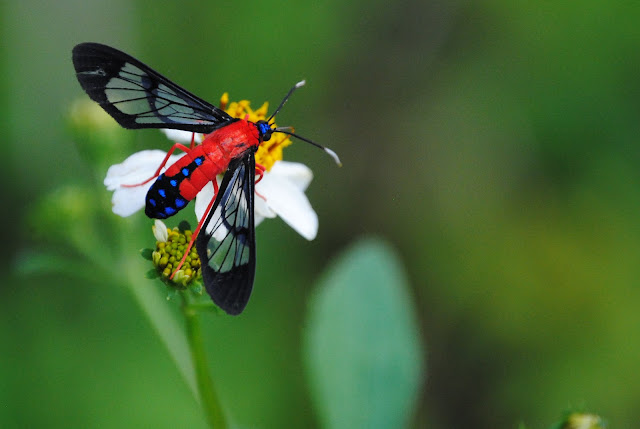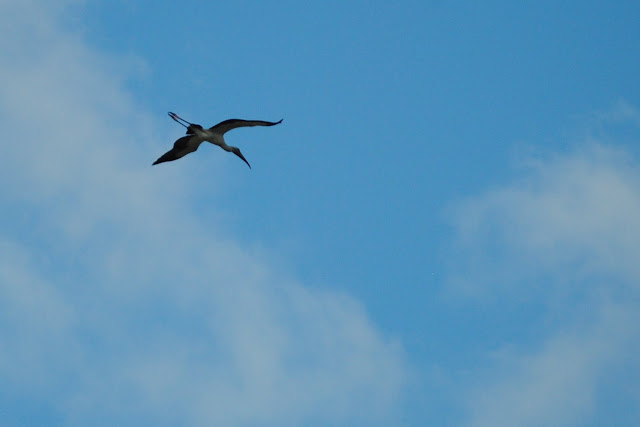American Bald Eagle (immature) (Haliaeetus leucocephalus).
Photonaturalist Steve Scott, Landscapes, macro, flora, fauna in the country, suburbs and city. Lots of interesting links about the world of nature.
Thursday, December 29, 2011
Monday, December 19, 2011
Wood Storks: Everglades Indicator Species
The Wood Stork (Mycteria americana) is the only breeding stork in North America, and is an indicator species for the health of the Everglades.
This large wading bird has been taken off the Endangered list, and is now considered a Threatened species.
It's always a great day to go birding in Florida!
Friday, December 9, 2011
Scarlet-bodied Wasp Moth
Scarlet-Bodied Wasp Moth (Cosmosoma myrodora). This small, brightly colored, wasp-like creature is actually a moth mimicing a wasp in order to avoid predators.
Feeding on a Common Beggar-Tick (Bidens alba) wildflower.
So many moths, so little time!
My very helpful Kaufman's Field Guide.
Sunday, December 4, 2011
Don Pedro Island State Park: Sierra Club Paddle & Nature Walk

The Charlotte Harbor, Florida Sierra Club has an active schedule with many paddle and hike outings. This one took place at Don Pedro State Park in Placida, Florida. The park is unique with a Land Base on the mainland and an unspoiled beach on the island which can only be reached by boat.
Don Pedro Island is one of Gulf Coast Florida's beautiful barrier islands.
The Land Base has a picnic area, restrooms, shower and several hiking trails through Pine Flatwoods Forest.
The Land Base also has a fishing dock.
The kayak launch area was more than adequate to get the groups' ten boats in the water, which was still warm on this nice December day.
Much of the island and surrounding coastline is Mangrove Forest.
Directly across the Intracoastal is a hidden mangrove tunnel which leads to a Secret Lagoon
Prop Roots of Red Mangrove (Rhizophora mangle) trees.
At mid-tide the tunnel is just inches deep and only kayaks and small canoes get through.
The water was clear enough to see this Sea Star (Echinaster sentus).
The entrance to the Secret Lagoon.
Lots of healthy Turtle Grass (Thalassia testudinum) in both the mangrove tunnel and the lagoon.
Check out the above schedule and come along on a Sierra Club outing here in Florida.
Biologist Bill did some wading and scooping in order to show us some of the marine creatures living in the lagoon.
Here's a Horse Conch (Pleuroplloca gigantea) which he found feeding on a Hard Clam (Mercenaria mercenaria).
Gotta beat the tide back out through the tunnel and on to the Island Beach landing.
The Beach has a really nice dock for boats and a very tight landing for kayaks.....but a nice rack to store them while you hike or soak up the sun.
Several Nature Trails meander through the dunes and onto the beach. The plant life has been meticulously restored to the native habitat.

Gulf Muhly Grass (Muhlenbergia capillaris var. filipes).
This native grass grows well on the dunes and when in bloom takes on a purple color.
Lots to look at and learn on a Barrier Island Beach.
Railroad Vine (Ipomoea pes-caprae). This cousin of the Morning Glory is also called Beach Vine or Goat Vine. The leaves are thought to resemble a goat's hoof print.
Still lots of dead fish from last month's Red Tide bloom.
Florida's Sierra Club is working hard to minimize Red Tide and other Harmfull Algal Blooms and ensure clean water.
I had time after the group left to explore the Land Base Nature Trails and saw this Mangrove Buckeye (Junania genoveva).
Cassius Blue (Leptotes cassius).
Red-shouldered Hawk (Buteo lineatus).
Wood Stork (Mycteria americana), a bellweather of a healthy Florida environment.
White Peacock (Anartia jatrophae).
Bald Eagle (Haliateetus leucocephalus) nest.
Raccoon (Procyon lotor) track
Florida State Parks offer a chance to see "The Real Florida."
Come along and join us on a Sierra Club Outing.
Subscribe to:
Posts (Atom)















































